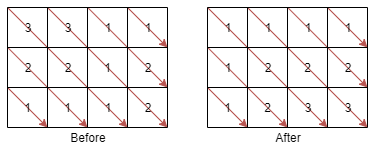A matrix diagonal is a diagonal line of cells starting from some cell in either the topmost row or leftmost column and going in the bottom-right direction until reaching the matrix's end. For example, the matrix diagonal starting from mat[2][0], where mat is a 6 x 3 matrix, includes cells mat[2][0], mat[3][1], and mat[4][2].
Given an m x n matrix mat of integers, sort each matrix diagonal in ascending order and return the resulting matrix.
Example 1:

Input: mat = [[3,3,1,1],[2,2,1,2],[1,1,1,2]]
Output: [[1,1,1,1],[1,2,2,2],[1,2,3,3]]
Example 2:
Input: mat = [[11,25,66,1,69,7],[23,55,17,45,15,52],[75,31,36,44,58,8],[22,27,33,25,68,4],[84,28,14,11,5,50]]
Output: [[5,17,4,1,52,7],[11,11,25,45,8,69],[14,23,25,44,58,15],[22,27,31,36,50,66],[84,28,75,33,55,68]]
Constraints:
m == mat.lengthn == mat[i].length1 <= m, n <= 1001 <= mat[i][j] <= 100
这道题让给一个矩阵的对角线排序,然后返回排序后的矩阵。对角线的排序可不像矩阵的行或者列排序那么容易,想要按顺序遍历对角线绝非易事,需要很复杂的坐标变换。这道题实际上考察了一个对角线坐标的性质,即处于同一条对角线上的点的横纵坐标的差均相同。这其实也不难理解,因为同一条对角线上的点可以看作是共线的,那么其斜率是相同的,则横纵坐标的差值一定相同。知道了这条性质后,对于任意一个坐标位置 (i, j),就知道其属于 i-j 的那条对角线,于是可以建立一个差值和其对应的所有的点的映射,将同一条对角线上的所有点放到一个数组中,然后再对每个一个数组排序,注意这里是按从大到小排序,这样从后往前取就是所求的顺序了。之后再遍历一次矩阵,对于每一个位置 (i, j),到 i-j 对应的集合中,取出当前最后的一个数字用来更新 mat[i][j] 即可,参见代码如下:
class Solution {
public:
vector<vector<int>> diagonalSort(vector<vector<int>>& mat) {
int m = mat.size(), n = mat[0].size();
unordered_map<int, vector<int>> diagMap;
for (int i = 0; i < m; ++i) {
for (int j = 0; j < n; ++j) {
diagMap[i - j].push_back(mat[i][j]);
}
}
for (auto &a : diagMap) {
sort(a.second.rbegin(), a.second.rend());
}
for (int i = 0; i < m; ++i) {
for (int j = 0; j < n; ++j) {
mat[i][j] = diagMap[i - j].back();
diagMap[i - j].pop_back();
}
}
return mat;
}
};
Github 同步地址:
https://github.com/grandyang/leetcode/issues/1329
参考资料:
https://leetcode.com/problems/sort-the-matrix-diagonally/
LeetCode All in One 题目讲解汇总(持续更新中...)
标签:Sort,sort,matrix,int,mat,1329,对角线,排序,Matrix From: https://www.cnblogs.com/grandyang/p/17075700.html